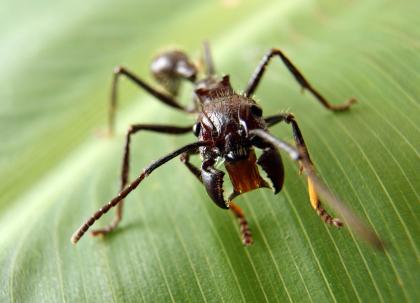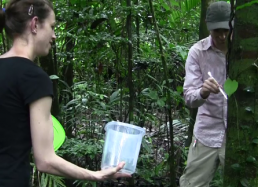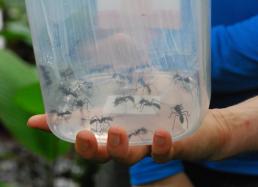Blog #11: The Bullet Ant Ballad
For the past week or so, we’ve had quite a bit of success in finding many of the ant species we came to collect. One particularly elusive ant, however, has been Paraponera clavata, known widely as the “bullet ant.” This species has earned their nickname due the incredibly painful sting they deliver, which supposedly feels just like a bullet wound. Multiple stings can land you in the hospital.
Aside from the sting, another defining characteristic is their size. Bullet ants are the runner-up in the world's largest ant competition (they're second only to Dinoponera). Despite their large size, we’ve had absolutely no luck in finding any. And, unfortunately, the project that I’m working on back at the Museum requires that I find this species while I’m here.
Determined, we began asking some of the locals about the kind of environment in which they’ve typically seen this hard-to-find species. We were told that bullet ants are often spotted climbing down the vines around large, old trees in the higher elevations of the forest, where there's significantly more rainfall than the locations we've been searching.
So today, we set out to find them. After traveling several hours along unpaved, rocky roads through the countryside of Costa Rica, we finally came to a portion of rainforest where we believed they might be found. Before setting out with our collecting gear however, we decided that perhaps we should write a little song for the bullet ants.
Like Native Americans and their rain dances, we playfully did a song and dance about finding the bullet ants in the hopes that it would help us visualize our success and achieve our goals. With our goofiness captured on video (see “Video Journal #7: Bullet & Trap-jaw Ants”), we set out to try our luck once again.
This terrain turned out to be vastly dissimilar to where we’d spent the last week or so. It was immediately evident that the forest was of a completely different variety, being permanently soaked from the rain. (It actually rained for quite some time while we were there.)
Lo and behold, after about an hour of carefully examining the vine growth around trees that looked ancient and majestic, the first bullet ant was spotted. And then another. And another. They seemed to use the vines as trails for traveling from the treetop to the base where their nests were located (see Photo #1 below.)
I was immediately taken aback by their size. It’s one thing to see a picture of such a large ant, or to be told that they’re almost an inch long, but to see it in person ... it felt as though I was watching some relic left over from the era of dinosaurs. In fact, everything in this forest felt ancient. The richness of the soil and the air, the strange guttural sounds of the howler monkeys in the distance, and these majestic ants. Something about their appearance commanded a kind of reverence.
Their feared status and notorious sting made me think that they’d be an aggressive ant to catch, yet they seemed quite the opposite. Someone noted that you could actually tap them on the head with our long forceps, and rather than going into “attack mode” or running away, these graceful creatures just casually looked around, as if wondering what was trying to get their attention.
Now back at the field station, I can't help but continue to watch their behavior as they groom each other and inspect the inside of the plastic containers that we collected them in (see Photo #2 below.) We’re keeping them alive while at the field station so as to perform diet experiments on them.
I can't get over how interesting their behavior is. While it may be my downfall to anthropomorphize our collected specimens, I can't help but feel that they have a sense of empathy and compassion for one another. I’d love to do a behavioral study on this species one day….
Here’s to a noble ant species!
Arista





